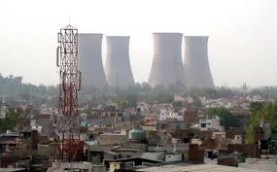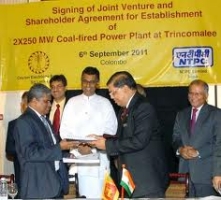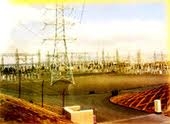India
Alstom launches turbine for low wind sites
Alstom has launched its ECO 122 –a 2.7 Mw onshore wind turbine for the low wind regions. This new turbine with high power and capacity offers increased energy yield.
Alstom launches turbine for low wind sites
Alstom has launched its ECO 122 –a 2.7 Mw onshore wind turbine for the low wind regions. This new turbine with high power and capacity offers increased energy yield.
NTPC eyes long-term supply of imported coal
India's NTPC is contemplating long-term off-take of coal from foreign coal companies to meet the target of imported coal besides scouting for other sources.
Power Grid commissions transmission lines for Mundra UMPP
Power Grid Corporation of India has commissioned the transmission system for two units of the Mundra Ultra Mega Power Project in Gujarat.
Orient Green Power reaches 300 MW renewable energy capacity
Orient Green Power Company Limited synchronized another 40.80 Mw capacity to the state grid of Tamil Nadu. This Wind Farm is located at Kazugumalai in the Tirunelveli / Thuthukudi districts in Tamil Nadu.
India thermal capacity target unlikely to materialize
India is on the verge of missing the capacity addition targets for 11th Plan, with a cumulative capacity addition of merely 8,101 MW during the third quarter of FY 2011-12.
ABB to supply substations to Indian steel plant
ABB won a US$71 million contract to supply substations from the Steel Authority of India.
India-US nuke implementation to take at least 2 years
The implementation of the Indian-US civil nuclear deal will take at least two years finalisation of the business model between India's NPCIL and US vendors.
NTPC, Ceylon Electricity Board incorporate JV in Sri Lanka
A joint venture that would set up a 500 Mw coal-based power plant in Sri Lanka has been incorportated by India's NTPC and the Ceylon Electricity Board.
Reliance Power eyes top spot in Indian private power production
Anil Ambani announced that his firm Reliance Power is poised to become the country’s largest private sector power generation and coal mining company in the next five years.
Bangladesh power firm likely to post $1.1B loss
State-run Bangladesh Power Development Board is expected to post a loss of nearly $1.1 billion in the year ending June 2012.
India thermal capacity addition target for 11th Plan unlikely to materialize
The country is on the verge of missing the capacity addition targets for 11th Plan, with a cumulative capacity addition of merely 8,101 MW during the third quarter of FY 2011-12 likely to increase the burden of achieving the target for the last quarter of the year. The goal for the 11th plan was initially set to 78,577 MW, which was later scaled down to 62,374 MW by the Planning Commission. Even this revised target seems to be out of reach, since only 50,282 MW will be added by the third quarter end and the remaining amount of 11,092 MW will be too high to be achieved in the last quarter. The situation for the ongoing quarter looks bleak, with the estimated addition for the month of September likely to fall short of its target of 7,743 MW. Although the thermal capacity addition is likely to double over a period of 4 months from 6,580 MW to 13,101 MW, the goals set for the quarter are too ambitious and may not be fulfilled by the contribution of thermal and hydro sectors. According to the estimates provided by the Central Electricity Authority (CEA), the capacity addition by nuclear sector will amount to 1,000 MW for both November and December, whereas that by hydro sector will only increase by 580 MW during the quarter period.
OGPL reaches 300 Mw renewable energy capacity
Orient Green Power Company Limited (OGPL), a renewable energy company said that, through its subsidiary Beta Wind Farms Ltd, it synchronized another 40.80 Mw capacity to the state grid of Tamil Nadu. This Wind Farm is located at Kazugumalai in the Tirunelveli / Thuthukudi districts in Tamil Nadu. Orient Green Power Europe a subsidiary of OGPL also synchronized 10.5 Mw in Croatia recently. With these additions, OGPL has attained an operating capacity of 250 Mw of wind energy apart from the 50 Mw of Biomass based power. With 245 Mw of green power in Tamil Nadu, OGPL is one of the leading renewable energy IPP in the state. OGPL’s total operating capacity totals to 300 Mw comprising both wind and biomass. During the current financial year the company has added 80 Mw till date and plans to add another 147 Mw before this fiscal. Another 100 Mw of Wind capacity is planned to be added by June’12 – before the beginning of next wind season. Plans are on to add further capacities in Karnataka, Andhra Pradesh and also in possibly Maharashtra. The steady increase in capacity will see the company consolidate its position as the leading independent renewable energy-based power generation company in India. T Shivaraman, vice chairman, OGPL, said, “We plan to cross 500 Mw mark by Q2 of 2012-13 and will continue to be a significant player in the Renewable Energy space in India. This capacity addition will lead to enhanced availability of power, especially in rural Tamil Nadu and also offers employment to the people in the region directly and indirectly.
Areva to construct 2 high voltage substations in India
Areva T&D India will construct two 765kV extra-high-voltage substations worth US$45 million in the Indian states of Madhya Pradesh and Maharashtra.
Indian power utilities unhappy with pricing methodology
Indian power utilities refused to enter into Transmission Services Agreement with the Power Grid Corporation of India Limited due to the new 'Point of Connection pricing methodology. Much of the resistance has been directed at the substantial increase in the transmission tariff, following the regulation. Moreover, the charges are still higher for state generators. Orissa and Bihar, for example, are required to pay more while scheduling power from an inter-state generating station located within the state. Resistance has also been expressed over the basis of calculations for the tariff. Private power producers have complained that the PoC calculations are done on the basis of average energy scenario, instead of the required five seasonal scenarios, with peak and off-peak periods. In its defense, CERC has asserted that since it did not receive individual data from the states, it had to resort to using the average energy scenarios, instead. In fact, it claimed that a single PoC rate for the year is easy to comprehend and administer and gives a more stable signal. Utilities have also alleged that the present scenario, where actual PoC rates are converted into slabs, has resulted in cross subsidization. Nonetheless, the power watchdog has defended use of the slab approach, terming it to be a variant of the 'Min-max Fairness' principle, which would enable easy comprehension by the stakeholders as well as provide stability and certainty to the transmission pricing signal.
Indian Hydro Project Exposes World Bank's Abuse of Climate Funds
If the World Bank and an Indian power utility have their way, the Rampur hydropower project in Northern India will increase global CO2 emissions by 15 million tons, at a cost of $164 million to unsuspecting energy consumers in Sweden. The project is a textbook example of how hydropower companies and other investors, with support from the World Bank, are gaming the system of climate finance. Rampur is a 412-megawatts hydropower project on the Satluj River in the Indian state of Himachal Pradesh. Satluj Jal Vidyut Nigam Limited (SJVN), an Indian hydropower company originally created by the World Bank, signed an agreement with the local government to implement the project back in 2004. The Indian Prime Minister laid the foundation stone in 2005. The World Bank approved a loan of $400 million for Rampur in 2007. Throughout this process, the hydropower company SJVN assured the public and its lenders that the scheme was a "least cost" project and would remain financially viable even under adverse hydrological conditions. At no time did it indicate that the project depended on carbon credits to go forward. Several years into project construction, t
Bangladesh eyes $3B investment on solar energy
Solar energy can help expand information technology across rural Bangladesh, according to Energy Adviser Dr. Tawfiq-e-Elahi Chowdhur
NTPC targets 128,000 MW capacity by 2032
NTPC announced a Corporate Plan target of having a 128,000 MW capacity by 2032.












 Advertise
Advertise


















